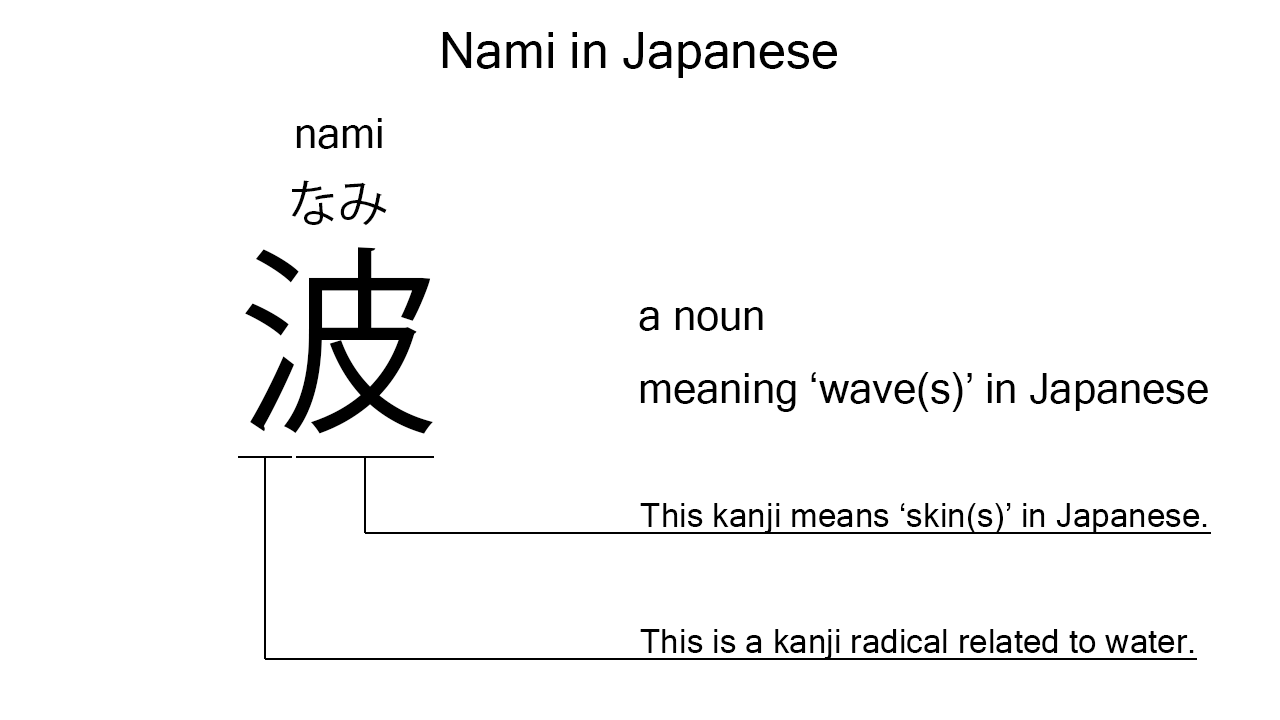What does “nami” mean in Japanese?
There are a few homophones, but native speakers use nami normally to mean a ‘wave’ in Japanese. Perhaps, some Japanese learners know this word as it is sometimes used in Japanese movies, songs, novels, manga, anime, and the like. In this blog post, however, I’m explaining this word in detail based on its kanji character. And also, I’m explaining how to use it through example sentences. My explanations would help Japanese learners understand nami more clearly. Then, let’s get started!
Contents
Definition and meaning of “nami”
Let me start with the definition and meaning of nami.
- nami – 波 (なみ) : a noun meaning a ‘wave’ in Japanese. This can also work as plural. Learn more about Japanese plural.
Normally, Japanese native speakers use this noun to refer to waves of water. Sometimes, however, they use this as a metaphor for the ups and downs of trends, activities, or even emotions.
The definition and meaning are simple and clear. To understand this noun more clearly, however, let me explain its kanji character in detail.
What does “nami” literally mean in Japanese?
The kanji character of nami consists of the following two parts:
- 氵 : a kanji radical related to water.
- 皮 : a kanji character widely used to mean a ‘skin’ in Japanese.
From these two kanji parts, we can understand that the formed character literally means ‘water skins’ in Japanese. This literal interpretation is not completely in line with the actual meaning, but still understandable, I think. Waves can often be considered as the top layer – the skin – of water.

When we meet new kanji characters, we should check their parts in detail to understand their meanings clearly and deeply. In many cases, kanji parts tell us a lot about the meanings of the characters they form. Actually, here, we could get the better understanding of nami through the detailed check above.
So far, I’ve explained the definition and meaning of nami together with its kanji parts. Then, let me explain how to use it through the example sentences below.
How to say “waves” in Japanese
nami ga kaigan ni uchiyoseru – 波が海岸に打ち寄せる (なみがかいがんにうちよせる)
Waves break on the seashore.
Below are the new words used in the example sentence.
- ga – が : a case particle used to make the subject word or the object word in a sentence. In the example, this is used after nami to make the subject in the sentence.
- kaigan – 海岸 (かいがん) : a noun meaning ‘the seashore’ in Japanese.
- ni – に : a case particle used to say in which direction an action goes. In the example, this is used after kaigan to say in which direction the action described by the following verb goes.
- uchiyoseru – 打ち寄せる (うちよせる) : a verb meaning ‘to break (on the seashore)’ in Japanese. This is a kind of special verb used to say that waves break on the seashore.
This is a typical usage of nami. In this example, it works together with the case particle, ga, to become the subject in the sentence. When we want to refer to waves in Japanese, anyway, this noun is always a very good option.
Another example of “nami”
kanojo no kanjou no nami wa hageshii – 彼女の感情の波は激しい (かのじょのかんじょうのなみははげしい)
Her emotional ups and downs are intense.
Below are the new words used in the example sentence.
- kanojo – 彼女 (かのじょ) : a pronoun meaning ‘she’ in Japanese.
- no – の : a case particle used after a noun or pronoun to make its possessive case. In the example, this is used after kanojo to make its possessive case, kanojo no, which means ‘her’ in Japanese.
- kanjou – 感情 (かんじょう) : a noun meaning an ’emotion’ in Japanese. This can also work as plural.
- no – の : a case particle joining two nouns or noun equivalent words. Normally, the first one can work as a modifier to describe the second. In the example, this works to join kanojo no kanjou and nami. The formed phrase literally means ‘the waves of her emotions’ in Japanese. Word orders in Japanese and English are different, but the role of this case particle is similar to that of the English preposition, of.
- wa – は : a binding particle working as a case marker or topic marker. In the example, this works after kanojo no kanjou no nami to make the subject in the sentence.
- hageshii – 激しい (はげしい) : an i-adjective meaning ‘intense’ or such in Japanese.
This is another example of nami. In this example, it works as a part of the commonly-used phrase, kanjou no nami, which literally means ‘waves of emotions’ in Japanese. So, it works as a metaphor for the emotional ups and downs.
Summary
In this blog post, I’ve explained the definition and meaning of nami in detail based on its kanji character. And also, I’ve explained how to use it through the example sentences. Let me summarize them as follows.
- nami – 波 (なみ) : a noun meaning a ‘wave’ in Japanese. This can also work as plural. This kanji character literally means ‘water skins’ in Japanese. This literal interpretation is not completely in line with the actual meaning, but still understandable, I think. Waves can often be considered as the top layer – the skin – of water. Normally, Japanese native speakers use this noun to refer to waves of water. Sometimes, however, they use this as a metaphor for the ups and downs of trends, activities, or even emotions.
Hope my explanations are understandable and helpful for Japanese learners.
Leave a Reply